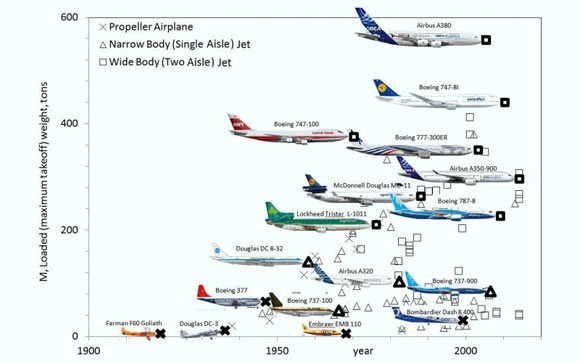A new study, published in the Journal of Applied Physics, uses a now-famous law of physics called the Constructal law to witness the evolution of airplane designs over time and predict the future of aerospace design.

According to Prof Adrian Bejan, the supersonic trans-Atlantic Concorde aircraft went the way of the dodo – it hit an evolutionary cul-de-sac. This image shows the British Airways Concorde in 1986. Image credit: Eduard Marmet / CC BY-SA 3.0.
One of the traditional arguments against Darwinian evolution has been that no one can confirm the process exists because it occurs on a time scale immensely greater than a human lifetime.
Prof Adrian Bejan of Duke University has disagreed with that notion ever since 1996 when he discovered a fundamental principle of physics that underlies the evolution of flow systems as they change in design over time – the Constructal law.
In the new study, Prof Bejan and his co-authors applied the Constructal law to airplanes, showing, “that we can witness evolution in our lifetime by documenting the evolution of a flow system that is a little more than a century old.”
“The evolution of Earth’s species occurred on a timescale far too large for humans to witness. But the evolution of our use of technology and airplanes to transport people and goods has taken place in little more than a single lifetime, making it visible to those who look. Evolution is a universal phenomenon encompassing technology, river basins and animal design alike, and it is rooted in physics as the Constructal law,” explained Prof Bejan, who is the lead author on the study.
In the case of aircraft, designs have evolved to allow more people and goods to flow across the face of the Earth.
The Constructal law has also dictated the main design features needed for aircraft to succeed – the engine mass has remained proportional to the body size, the wing size has been tied to the fuselage length, and the fuel load has grown in step with the total weight.

The evolution of the major airplane models during the 100-year history of aviation. Image credit: A. Bejan et al.
“We showed that larger airplanes are faster, more efficient as vehicles, and have greater range. Engine mass is proportional to body mass, a design feature that is the same in animals where the mass of the motive organs – muscle, heart and lungs – is proportional to body mass,” Prof Bejan said.
The scientists also identified one outlier – the Concorde, a retired turbojet-powered supersonic passenger airliner.
“The Concorde was too far off from the ratios that evolution has produced in passenger jets,” Prof Bejan said.
“The doomed aircraft had limited passenger capacity, a low mass-to-velocity ratio, an off-the-charts fuselage-to-wingspan ratio, massive engines and poor fuel economy. It would have had to adhere to the constructal design rules to succeed.”
Because the data in the study show that airplane design has followed an evolutionary path dictated by the Constructal law, Prof Bejan believes that it should be easy to predict the next stages.
“This study gives the rough sketch of what airplane designs will put you in the game. For design companies, it is money in the bank,” Prof Bejan said.
_____
A. Bejan et al. 2014. The evolution of airplanes. J. Appl. Phys. 116, 044901; doi: 10.1063/1.4886855







